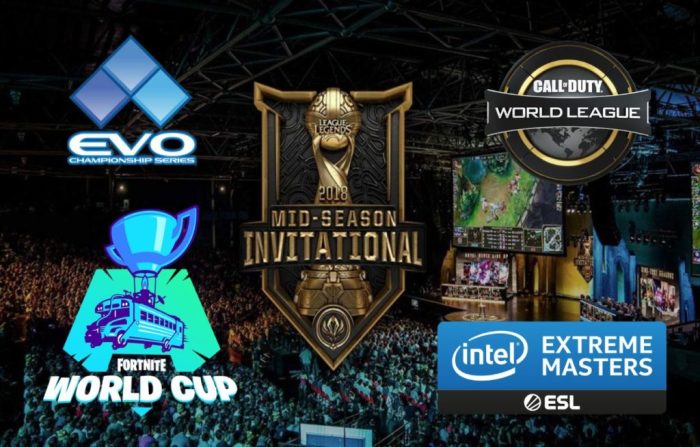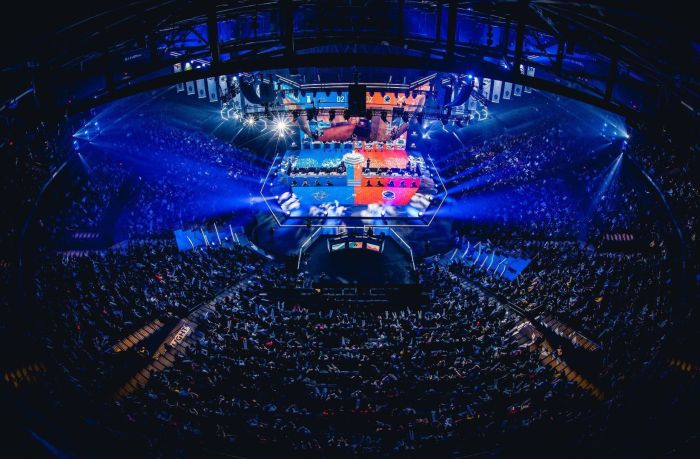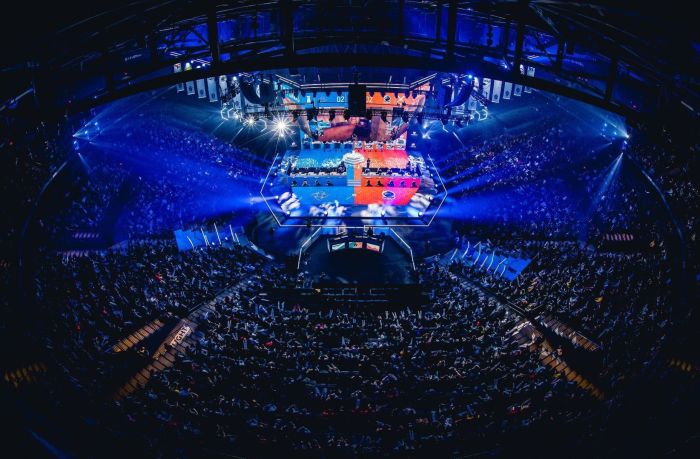Esports competitions are exploding in popularity, transforming from niche hobby to a global phenomenon. This isn’t just about gamers; it’s a massive industry encompassing sophisticated tournament structures, lucrative sponsorships, and a dedicated, passionate fanbase. We’ll explore the multifaceted world of competitive gaming, from the various formats and strategies employed to the technology driving its growth and the future trends shaping its evolution.
This exploration will cover everything from the nuts and bolts of tournament structures – like single-elimination brackets versus round-robin formats – to the impact of sponsorships on prize pools and player performance. We’ll delve into the demographics of the esports audience, examine the role of technology in enhancing the viewing experience, and even speculate on what the future holds for this dynamic and ever-evolving landscape.
Esports Competition Formats

So, you wanna understand how esports tournaments are structured? It’s way more complex than just “best of three,” trust me. Different formats create wildly different competitive landscapes and viewer experiences. Let’s break down some of the most common ones and then I’ll throw in a crazy idea of my own.
The format of an esports competition significantly impacts the overall experience for both the players and the viewers. Choosing the right format requires careful consideration of various factors, including the number of participants, the time constraints, and the desired level of competitiveness and viewer engagement. Different formats highlight different strengths and weaknesses of teams and players, leading to diverse and engaging tournament narratives.
Esports Tournament Structures
Here’s a breakdown of some common esports competition formats, highlighting their pros and cons. Think of this as your cheat sheet for understanding the tournament scene.
| Format Name | Description | Advantages | Disadvantages |
|---|---|---|---|
| Single-Elimination | Teams play a single match; one loss and you’re out. Winner moves on to the next round until a champion is crowned. | Simple to understand, creates high stakes and dramatic moments, relatively short tournament length. | One bad game can eliminate a strong team, less opportunity for teams to showcase their skill, less overall matches played. |
| Double-Elimination | Teams have a second chance after one loss. They move to a “loser’s bracket” and must win multiple matches to reach the grand finals. | Gives teams a second chance, more matches played, offers a more comprehensive assessment of team strength. | Longer tournament length, can be less dramatic than single-elimination for viewers initially. |
| Round-Robin | Each team plays every other team once (or multiple times). Standings are determined by wins and losses. | Provides a fairer assessment of team skill over multiple matches, consistent gameplay for viewers. | Can be very long, especially with many teams, less dramatic than elimination formats. |
| Group Stage | Teams are divided into groups, playing a round-robin or other format within their group. Top teams from each group advance to a playoff bracket (often single or double-elimination). | Combines the best aspects of round-robin and elimination formats, allows for a large number of participants, builds anticipation for playoffs. | Can be complex to follow, some teams may get eliminated early despite strong performance. |
Comparison of Tournament Structures
The effectiveness of different tournament structures in fostering competitive balance and viewer engagement is a complex issue. Single-elimination formats, while exciting, can be unfair to teams that might have an off day. Round-robin formats offer a more balanced assessment but can lack the high-stakes drama of elimination brackets. Group stages offer a compromise, combining the best of both worlds. The ideal format often depends on the specific game, the number of participants, and the overall goals of the tournament.
For example, a fighting game tournament might favor a double-elimination format to give players a second chance to recover from a surprise loss, while a strategy game might benefit from a round-robin format to ensure a more comprehensive evaluation of team strategies over multiple matches. The League of Legends World Championship utilizes a group stage followed by a single-elimination bracket to balance competitive fairness with exciting, high-stakes playoffs.
A Novel Esports Competition Format: The “Swiss-Style” Elimination
Let’s imagine a new format that blends the best elements of Swiss pairings with elimination-style drama. We call it the “Swiss-Style” Elimination. This format uses a Swiss pairing system for the initial rounds, matching teams of similar win/loss records. This ensures competitive balance throughout the tournament. After a set number of rounds (e.g., 5), the top X teams based on their record advance to a double-elimination bracket.
This combines the fairness of the Swiss system with the high-stakes excitement of a knockout stage. The potential benefits include improved competitive balance, more engaging matches for viewers due to closer skill-level pairings, and a more nuanced assessment of team strength.
Think of it like a chess tournament: early rounds are carefully matched, and then the top performers battle it out in a thrilling final stage. This system offers a compelling blend of fair competition and edge-of-your-seat excitement.
The Role of Sponsors and Prize Pools: Esports Competitions

Esports competitions wouldn’t exist as we know them without the crucial partnership between sponsors and the prize pools they help create. This symbiotic relationship fuels the growth of the industry, attracting both top-tier talent and a massive global audience. The size and structure of prize pools directly impact player participation and performance, while the involvement of sponsors ensures the long-term financial health and sustainability of the entire ecosystem.Sponsorships are the lifeblood of many esports competitions, providing the necessary funding to run events, pay players, and create a captivating viewing experience.
Without substantial sponsorship, many tournaments simply wouldn’t be possible. The money injected by sponsors directly translates to better production quality, increased prize money, and broader reach for the competition.
Types of Sponsors and Their Contributions
Sponsors contribute in diverse ways, each playing a vital role in the success of an esports competition. Understanding these contributions helps illustrate the complexity and importance of securing diverse sponsorship deals.
- Hardware and Software Companies: Companies like Razer, Logitech, and Alienware often sponsor teams and tournaments, providing equipment to players and integrating their products into broadcasts. Their contributions directly improve the player experience and enhance the visual appeal of the competition for viewers.
- Energy Drink and Food Companies: Red Bull, Mountain Dew, and other brands frequently sponsor esports events, providing refreshments to players and viewers, and using the events for brand promotion. This kind of sponsorship helps increase brand visibility within the target demographic.
- Financial Institutions and Telecommunications Companies: Banks and telecom providers are increasingly becoming involved, recognizing the large and engaged audience of esports. Their sponsorship often involves branding and promotional activities during the competition.
- Streaming Platforms and Media Companies: Twitch, YouTube, and other streaming platforms often sponsor events or teams, gaining exposure for their services. This symbiotic relationship is crucial for the visibility and reach of esports events.
Prize Pool Size and Player Participation/Performance
The size of the prize pool is a significant factor influencing player participation and the intensity of competition. Larger prize pools attract more skilled players, leading to a higher level of competition and more exciting matches. This creates a positive feedback loop, drawing in more viewers and further increasing the value of sponsorships.Different prize pool models exist, each with its own advantages and disadvantages.
A “guaranteed prize pool” offers a fixed amount regardless of participation, while a “crowdfunded prize pool” relies on community contributions to supplement the sponsor’s contribution. A hybrid model, combining guaranteed and crowdfunded components, often provides the best balance, ensuring a substantial prize pool while also engaging the community. For example, The International, Dota 2’s annual championship, is famous for its massive crowdfunded prize pool, consistently breaking records and attracting the world’s best players.
In contrast, smaller tournaments with smaller guaranteed prize pools might attract a more regional or less experienced player base.
Securing Sponsorships and Managing Prize Money Distribution, Esports competitions
Esports organizations employ various strategies to secure sponsorships, including demonstrating the value proposition of their events (audience reach, demographics, engagement metrics), creating compelling sponsorship packages tailored to specific brands, and building strong relationships with potential sponsors. The process often involves detailed negotiations, contract drafting, and ongoing communication to ensure both parties benefit from the partnership.Prize money distribution is typically Artikeld in the competition rules and regulations, often following a tiered system that rewards the top-performing teams or players.
This can involve a percentage-based split, with the winner receiving the largest share, or a fixed amount for each placement. Transparency in prize money distribution is essential for maintaining trust and credibility within the esports community. Strict financial oversight and auditing are crucial to ensure fair and accurate disbursement of funds.
Question Bank
How much money can esports players make?
Earnings vary wildly, from nothing for amateur players to millions for top professionals in popular games. It depends heavily on skill, team success, sponsorships, and streaming income.
What are the most popular esports games?
Popular titles constantly shift, but games like League of Legends, Dota 2, Counter-Strike: Global Offensive, Valorant, and various fighting games frequently dominate the scene.
How do I become a professional esports player?
It takes immense dedication, skill, and often years of practice. Start by mastering a game, joining online communities, competing in smaller tournaments, and seeking out opportunities to improve.
Are esports officially recognized as a sport?
The recognition of esports as a sport is still evolving. While not universally recognized like traditional sports, many countries and organizations are increasingly acknowledging its competitive nature and professional status.
